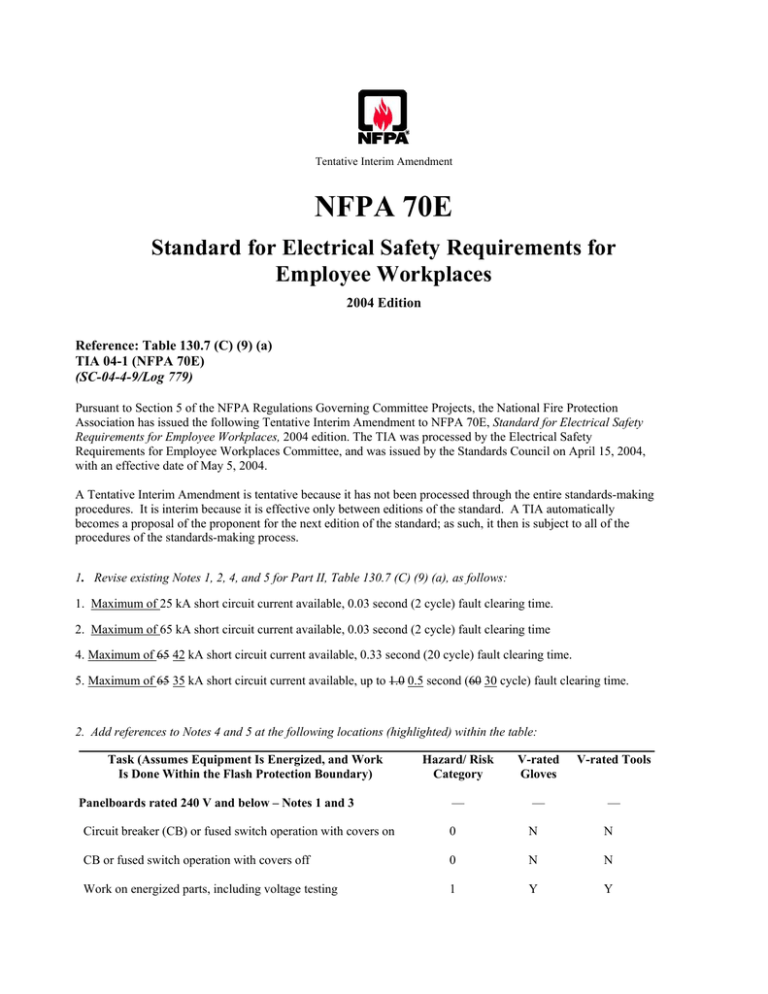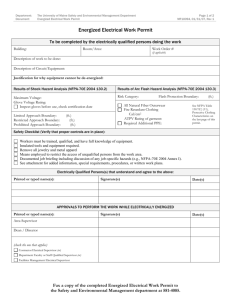
Tentative Interim Amendment
NFPA 70E
Standard for Electrical Safety Requirements for
Employee Workplaces
2004 Edition
Reference: Table 130.7 (C) (9) (a)
TIA 04-1 (NFPA 70E)
(SC-04-4-9/Log 779)
Pursuant to Section 5 of the NFPA Regulations Governing Committee Projects, the National Fire Protection
Association has issued the following Tentative Interim Amendment to NFPA 70E, Standard for Electrical Safety
Requirements for Employee Workplaces, 2004 edition. The TIA was processed by the Electrical Safety
Requirements for Employee Workplaces Committee, and was issued by the Standards Council on April 15, 2004,
with an effective date of May 5, 2004.
A Tentative Interim Amendment is tentative because it has not been processed through the entire standards-making
procedures. It is interim because it is effective only between editions of the standard. A TIA automatically
becomes a proposal of the proponent for the next edition of the standard; as such, it then is subject to all of the
procedures of the standards-making process.
1. Revise existing Notes 1, 2, 4, and 5 for Part II, Table 130.7 (C) (9) (a), as follows:
1. Maximum of 25 kA short circuit current available, 0.03 second (2 cycle) fault clearing time.
2. Maximum of 65 kA short circuit current available, 0.03 second (2 cycle) fault clearing time
4. Maximum of 65 42 kA short circuit current available, 0.33 second (20 cycle) fault clearing time.
5. Maximum of 65 35 kA short circuit current available, up to 1.0 0.5 second (60 30 cycle) fault clearing time.
2. Add references to Notes 4 and 5 at the following locations (highlighted) within the table:
Task (Assumes Equipment Is Energized, and Work
Is Done Within the Flash Protection Boundary)
Hazard/ Risk
Category
V-rated
Gloves
V-rated Tools
—
—
—
Circuit breaker (CB) or fused switch operation with covers on
0
N
N
CB or fused switch operation with covers off
0
N
N
Work on energized parts, including voltage testing
1
Y
Y
Panelboards rated 240 V and below – Notes 1 and 3
Task (Assumes Equipment Is Energized, and Work
Is Done Within the Flash Protection Boundary)
Remove/install CBs or fused switches
Hazard/ Risk
Category
1
V-rated
Gloves
Y
V-rated Tools
Y
Removal of bolted covers (to expose bare, energized parts)
1
N
N
Opening hinged covers (to expose bare, energized parts)
0
N
N
—
—
—
CB or fused switch operation with covers on
0
N
N
CB or fused switch operation with covers off
1
N
N
Work on energized parts, including voltage testing
2*
Y
Y
600 V Class Motor Control Centers (MCCs) – Notes 2 (except
as indicated) and 3
—
—
—
CB or fused switch or starter operation with enclosure doors
closed
0
N
N
Reading a panel meter while operating a meter switch
0
N
N
CB or fused switch or starter operation with enclosure doors open
1
N
N
Work on energized parts, including voltage testing
2*
Y
Y
Work on control circuits with energized parts 120 V or below
exposed
0
Y
Y
Work on control circuits with energized parts >120 V, exposed
2*
Y
Y
Insertion or removal of individual starter “buckets” from MCC –
Note 4
3
Y
N
Application of safety grounds, after voltage test
2*
Y
N
Removal of bolted covers (to expose bare, energized parts) –
Note 4
2*
N
N
Opening hinged covers (to expose bare, energized parts)
1
N
N
600 V Class Switchgear (with power circuit breakers or fused
switches) – Notes 5 and 6
—
—
—
CB or fused switch operation with enclosure doors closed
0
N
N
Reading a panel meter while operating a meter switch
0
N
N
CB or fused switch operation with enclosure doors open
1
N
N
Panelboards or Switchboards rated >240 V and up to 600 V
(with molded case or insulated case circuit breakers) – Notes
1 and 3
Task (Assumes Equipment Is Energized, and Work
Is Done Within the Flash Protection Boundary)
Hazard/ Risk
Category
V-rated
Gloves
V-rated Tools
Work on energized parts, including voltage testing
2*
Y
Y
Work on control circuits with energized parts 120 V or below,
exposed
0
Y
Y
Work on control circuits with energized parts >120 V, exposed
2*
Y
Y
Insertion or removal (racking) of CBs from cubicles, doors open
3
N
N
Insertion or removal (racking) of CBs from cubicles, doors
closed
2
N
N
Application of safety grounds, after voltage test
2*
Y
N
Removal of bolted covers (to expose bare, energized parts)
3
N
N
Opening hinged covers (to expose bare, energized parts)
2
N
N
Other 600 V Class (277 V through 600 V, Nominal)
Equipment – Notes 2 (except as indicated) and 3
—
—
—
Lighting or small power transformers (600 V, maximum)
—
—
—
Removal of bolted covers (to expose bare, energized parts)
2*
N
N
Opening hinged covers (to expose bare, energized parts)
1
N
N
Work on energized parts, including voltage testing
2*
Y
Y
Application of safety grounds, after voltage test
2*
Y
N
Revenue meters (kW-hour, at primary voltage and current)
—
—
—
2*
Y
N
Cable trough or tray cover removal or installation
1
N
N
Miscellaneous equipment cover removal or installation
1
N
N
Work on energized parts, including voltage testing
2*
Y
Y
Application of safety grounds, after voltage test
2*
Y
N
Insertion or removal
(Notes 1, 2, 4, and 5 are not applicable to the remainder of the table, so the rest of the table is not
shown.)
Copyright © 2004 All Rights Reserved
NATIONAL FIRE PROTECTION ASSOCIATION



